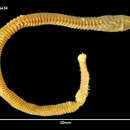en
names in breadcrumbs


“Augeneria tentaculata, n.sp.
St. 167. 20. ii. 27. Off Signy Island, South Orkneys. 60° 50' 30" S, 46° 15' 00" W. 244-344 m. Gear N 4-T. Bottom: green mud. Fourteen specimens.
St. 187. 18. iii. 27. Neumayr Channel, Palmer Archipelago. 64° 48' 30" S, 63° 31' 30" W. 259 m. Gear DLH. Bottom: mud. One specimen.
DESCRIPTION. The great majority of the specimens are incomplete posteriorly. The largest complete specimen measures 135 mm. by 3 mm. without the feet and has about 110 chaetigers.
All colour has disappeared from most of the specimens, but traces of a thin transverse colour band joining the bases of the feet remain in a few. When present, this does not begin before the 6th chaetiger. The body is of the usual "Lumbrinereis" shape, cylindrical in front and more flattened posteriorly : it does not taper at the ends.
The prostomium (Fig. 52, a) is of a rounded oval form without a trace of eyes. The three small subequal tentacles situated at the hinder edge of the prostomium are sometimes almost hidden in a groove where a crescentic re-entrant is carved out of the anterior border of the first segment. In this groove the evaginable nuchal organs are also situated. On the undersurface of the prostomium (Fig. 52, b) is a pair of large buccal cushions. The second segment is carried forward to form the lower border of the mouth in a manner similar to that in Lumbrinereis magalhaensis.
The 1st segment is about half as long again as the 2nd. The first two segments are achaetous. For the first five chaetigers the feet gradually increase in length. The anterior lip of the chaetal lobe is rounded and does not project, the posterior lip forms a conical process. There are no pedal cirri nor branchiae.
The anterior feet (Fig. 52, c) carry compound crochets and bordered capillaries (Fig. 52, d). In the compound crochets (Fig. 52, e) the end-piece or blade is rather short, its length being less than the length of the continuation of the cutting flange below the joint. At the apex of the blade there are about four teeth above the main fang.
In the middle feet compound crochets are replaced by simple crochets (Fig. 52,f) with four to five teeth, and the capillaries have narrower borders and long and extremely delicate ends. In each foot the most dorsal bristle is a single giant simple crochet (Fig. 52,g), of the same form as, but larger than the rest of, the crochets in the foot. In the posterior feet (Fig. 52, h) the postchaetal lobe becomes more pointed, and the bordered capillaries are replaced by simple capillaries. About the last 20 feet have simple crochets only.
I can see no acicula.
The lower jaw (Fig. 52, i) is rather short, longitudinally striated, and with small calcareous end-pieces. Regarding the maxillae (Fig. 52, k), M. I is a pair of simple black pincers. M. II is a pair of heavy plates with three teeth. M. III has two teeth. M. IV is a pair of large subrectangular plates without any clearly defined teeth. The carriers are narrow and pointed.
REMARKS. Except for the three tentacles this form is a typical Lumbrinereis ; but the presence of these structures places it outside the sub-family Lumbrinereinae, in which, however, I propose to leave it provisionally rather than create another sub-family. It may possibly be a link between the Lysaretinae and the Lumbrinereinae, but in its general characteristics it is closer to the latter family than to the former.”
(Monro, 1930)